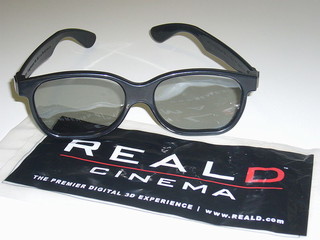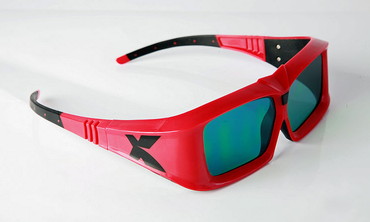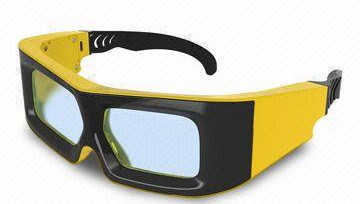Three Dimensional Cinema
A 3D ("three-dimensional") film is a motion picture that enhances the illusion of depth perception.
Derived from stereoscopic photography, a special motion picture camera is used to record the images as
seen from two perspectives (or computer-generated imagery generates the two perspectives), and special
projection hardware and/or eyewear are used to provide the illusion of depth when viewing the film.
3D films are not limited to feature film theatrical releases; television broadcasts and direct-to-video
films have also incorporated similar methods, primarily for marketing purposes.
3D films have existed in some form since 1890, but until recently had been largely relegated to a niche
in the motion picture industry because of the costly hardware and processes required to produce and display
a 3D film, and the lack of a standardised format for all segments of the entertainment business.
Nonetheless, 3D films were prominently featured in the 1950s in American cinema, and later experienced a
worldwide resurgence in the 1980s and 90s driven by IMAX high-end theatres and Disney theme park shows.
3D films became more and more successful throughout 2000-09, culminating in the unprecedented success
of 3D presentations of Avatar in December 2009, followed by the record-breaking opening of Tim Burton's
Alice in Wonderland in March 2010.
The basic method of presenting 3D hasn't changed in all the years of cinema. The idea is that, to see a 3D
image, each eye must be presented a slightly different image where objects are offset to produce the 3D effect.
What differs in the methods is how the two images are presented to the viewer.
Let's start with the poorest method - anaglyph - where the two images are superimposed in an additive light
setting through two filters, one red and one cyan. Glasses with coloured filters in each eye separate the
appropriate images by cancelling the filter colour out and rendering the complementary colour black. The
anaglyph 3D system was the earliest system used in theatrical presentations and requires no specialised hardware,
but the lack of colour fidelity and ghosting (where one eye sees a muted other eye image) makes it inferior.
In the post-50's era, anaglyph has been used in feature presentations where only part of the movie is in 3D such
as in the 3D segment of Freddy's Dead: The Final Nightmare and Spy Kids 3D. It has also been used
for television and video presentations with some improved filtering techniques yielding better colour rendering
using amber and dark blue lenses in the glasses. Here's an example of a typical red-blue anaglyph glasses of
the past.
 All the other 3D systems present two separate images on the screen, either superimposed, or alternating frames.
The polarising method passes each of these images through polarising filters. The viewer wears low-cost glasses
which also contain a pair of different polarising filters. As each filter passes only that light which is
similarly polarised and blocks the light polarised in the opposite direction, each eye sees a different image.
Either linear or circular polarising filters can be used, as long as
different orientations (horizontal vs. vertical, or clockwise vs. counterclockwise) are used for each eye.
Until recently, polarisation was linear, with the glasses often being in cardboard frames, like the anaglyph
ones. Here's another image.
All the other 3D systems present two separate images on the screen, either superimposed, or alternating frames.
The polarising method passes each of these images through polarising filters. The viewer wears low-cost glasses
which also contain a pair of different polarising filters. As each filter passes only that light which is
similarly polarised and blocks the light polarised in the opposite direction, each eye sees a different image.
Either linear or circular polarising filters can be used, as long as
different orientations (horizontal vs. vertical, or clockwise vs. counterclockwise) are used for each eye.
Until recently, polarisation was linear, with the glasses often being in cardboard frames, like the anaglyph
ones. Here's another image.
 The big problem with linear polarisation was that if a viewer tilted their head, ghosting appeared. This method
is used by IMAX cinemas these days. Note the large lenses to accommodate IMAX's larger image filling more of the
viewer's field of view.
The big problem with linear polarisation was that if a viewer tilted their head, ghosting appeared. This method
is used by IMAX cinemas these days. Note the large lenses to accommodate IMAX's larger image filling more of the
viewer's field of view.
 Resembling sunglasses, polarised glasses are very much the standard for theatrical releases and theme park
attractions. For 35mm and 70mm film (and true IMAX films), these involve two images on each frame of film
separated by a split lens, or two projectors synchronised to show the two pictures at once.
Resembling sunglasses, polarised glasses are very much the standard for theatrical releases and theme park
attractions. For 35mm and 70mm film (and true IMAX films), these involve two images on each frame of film
separated by a split lens, or two projectors synchronised to show the two pictures at once.
With the introduction of Digital Cinema in the last few years, high definition digitally recorded movies are
presented by high-brightness video projectors capable of higher colour depth and high frame rates. This has
enabled polarised methods to be applied to digital presentations.
In the case of RealD, a circularly polarising liquid crystal filter which can switch polarity 144 times per
second is placed on front of the projector lens. Only one projector is needed, as the left and right eye images
are displayed alternately. Each pair of frames occupies one twenty-fourth of a second and are repeated three
times (called triple flash). These images are at a resolution of 2048 by 858 for scope films and 1998x1080 for
widescreen. Sony features a new system called RealD XLS, which shows both circular polarised images
simultaneously: a single 4K projector (4096x2160 resolution) displays both 2K images (2048x858 resolution) above each other at the same time, a special lens
attachment polarises and projects the images on top of each other. Here's the RealD glasses, produced at low
cost, which were initially considered to be disposable. However, the green lobby has forced a recycling/reuse
regimen to their use.
This is the system used at Shellharbour Greater Union.
 Thomson Technicolor have produced a system using a split lens which allows traditional 35mm projectors to be
adapted to project in 3D using over/under 35mm film. (This is yet to be seen commercially, and may be some time
coming to Australia.) This is exactly the method used in the 50s to 80s, along with side-by-side images. It's is
a very cost-effective way to convert a cinema screen as all that is needed is the lens - and the silver screen
that is always required with polarised systems to maintain the polarisation when the image is reflected from the
screen.
Thomson Technicolor have produced a system using a split lens which allows traditional 35mm projectors to be
adapted to project in 3D using over/under 35mm film. (This is yet to be seen commercially, and may be some time
coming to Australia.) This is exactly the method used in the 50s to 80s, along with side-by-side images. It's is
a very cost-effective way to convert a cinema screen as all that is needed is the lens - and the silver screen
that is always required with polarised systems to maintain the polarisation when the image is reflected from the
screen.
Polarised stereoscopic pictures have been around since 1936, when Edwin H. Land first applied it to motion
pictures. The so called "3D movie craze" in the years 1952 through 1955 was almost entirely offered in theatres
using polarising projection and glasses. Only a minute amount of the total 3D films shown in the last 60 years
used the anaglyph colour filter method - even if the mainstream media imply that current 3D is different to
the way it was presented in the past.
Dolby 3D uses specific wavelengths of red, green, and blue for the right eye, and different wavelengths of red,
green, and blue for the left eye. Eyeglasses which filter out all but the very specific wavelengths allow the wearer to
see a 3D image. This technology, originally developed by the German company Infitec, eliminates the expensive
silver screens required for polarised systems such as RealD. It does, however, require much more expensive
glasses than the polarised systems. It is also known as wavelength multiplex visualisation. The nearest theatres
with Dolby3D are Readings at Rhodes and Castle Hill, and Greater Union Bondi Junction. The glasses are reused
after washing.
 The other method used to present 3D uses shutter glasses which allow each image on the screen to be viewed by
the correct eye. These glasses uses liquid crystal (LC) technology to block each eye repeatedly at 144 times a second. This was
the method used by IMAX cinemas before they went to the less expensive polarised glasses.
The other method used to present 3D uses shutter glasses which allow each image on the screen to be viewed by
the correct eye. These glasses uses liquid crystal (LC) technology to block each eye repeatedly at 144 times a second. This was
the method used by IMAX cinemas before they went to the less expensive polarised glasses.
 The earlier IMAX glasses even had speakers in them for interesting sound effects. The biggest problem with
shutter glasses is that these are active glasses which need power to operate - usually a battery. This makes
them more expensive to manufacture and require more maintenance than the passive glasses of Dolby3D or polarised
systems. The synchronisation is produced by an infra-red signal projected with the image, and picked up by an IR
detector in the glasses. The most popular brand name in this area is XpanD, which has the majority of 3D
screens in Europe, whereas RealD is dominant in the US. The nearest cinema with XpanD is Dendy Canberra.
The earlier IMAX glasses even had speakers in them for interesting sound effects. The biggest problem with
shutter glasses is that these are active glasses which need power to operate - usually a battery. This makes
them more expensive to manufacture and require more maintenance than the passive glasses of Dolby3D or polarised
systems. The synchronisation is produced by an infra-red signal projected with the image, and picked up by an IR
detector in the glasses. The most popular brand name in this area is XpanD, which has the majority of 3D
screens in Europe, whereas RealD is dominant in the US. The nearest cinema with XpanD is Dendy Canberra.
 As the reader might understand, 3D cinema involves a high level of investment - currently limited to major
chains and some entrepreneurial independents. The cost for a (2D) digital system is about $90,000, while the
three competing major suppliers of 3D (RealD, Dolby, and XpanD) add a further $50,000 to the cost - not counting
the costs of dishwashers, and higher levels of cinema personnel required with reusable glasses.
As the reader might understand, 3D cinema involves a high level of investment - currently limited to major
chains and some entrepreneurial independents. The cost for a (2D) digital system is about $90,000, while the
three competing major suppliers of 3D (RealD, Dolby, and XpanD) add a further $50,000 to the cost - not counting
the costs of dishwashers, and higher levels of cinema personnel required with reusable glasses.
So how does UniMovies figure in this new world of 3D? In 2009, we installed an NEC1600 digital projector and GDC
digital cinema server, which enables us to present 95% of our shows in digital. In 2010, we have installed a
less expensive (than XpanD) shutter glasses system, manufactured in China. While it may cost less, the results
are more than comparable. Here's what the glasses looked like.

 We called it UM3D. To cover the extra cost of the 3D system, and the extra maintenance required by
reusable glasses - not forgetting that film distributors expect more income from their 3D product - all cinemas
add a surcharge for 3D presentations. UniMovies surcharge is $2.
We called it UM3D. To cover the extra cost of the 3D system, and the extra maintenance required by
reusable glasses - not forgetting that film distributors expect more income from their 3D product - all cinemas
add a surcharge for 3D presentations. UniMovies surcharge is $2.
The import of the 3D glasses and ancillary equipment was picked up by a local
company and is now called Panastereo 3D. We have since purchased their branded
glasses, and have independently imported new kids size glasses and lightweight
clipon glasses, as shown below.

 Footnote:
Footnote:
With the advent of 3D television many will think that the glasses used in cinema 3D system will work at home.
Unfortunately, with the exception of some companies using polarisation, most manufacturers are using shutter
glasses that use a different IR frequency. Their glasses will be expensive and incompatible with either XpanD
or our system. For home computers, here's NVidia's computer solution using shutter glasses.

(Based on the Wikipedia entry on 3-D film - modified, localised and illustrated.)












